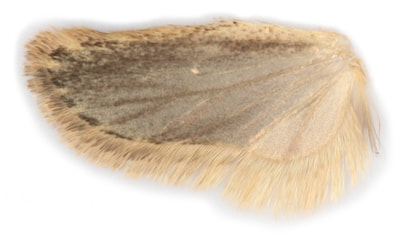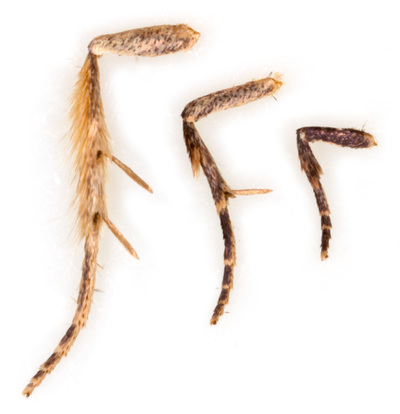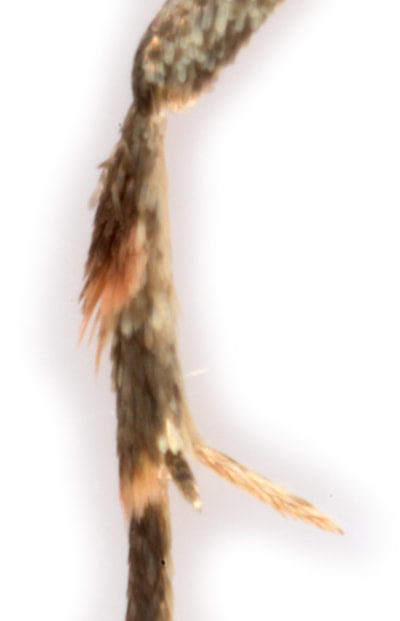32.040 Depressaria ultimella (Marsh Brown)
ws: 16-21mm; Aug-May; fool's water-cress (Apium nodiflorum), fine-leaved/hemlock water-dropwort (Oenanthe aquatica/crocata); locally fairly common in marshes around ponds, wet meadows and dykes in S&C England and Wales.
ID: From key in MBGBI4.1: forewing costal 2/5 not contrastingly reddish; without round white dot in disc at 2/3; labial palps S3 with 2 dark bands; > 4 species. D.heraclei is distinguished by having a row of discrete terminal dots - but this area is damaged in §1 making determination of this feature problematic. The remaining 3 species have an indistinct fascia at 3/4, which is angled at 80-100º in D.heraclei and at 40-60º in D.daucella and D.ultimella. D.daucella can be excluded on size - it is larger (ws:22-25mm). One needs the eye of faith to determine that an indistinct fascia is discernible in §1, but with that eye invoked the barely discernible fascia does seem to be acute. I could not confidently identify this specimen from the key without genital dissection.
Male genitalia: Depressaria genitalia are characterised by well-developed clavus lobes (at the bases of the sacculi) (these structures are not present in other Depressariid genera), and paired uncus lobes. Clear differences exist between the species in the shape of the clavi; the presence and extent of any process at or near the apex of the sacculus; the shape of the apex of the valva; the presence and extent of any process from the costal (dorsal) margin of the valva; the shape and extent of the uncus lobes; the shape of the vinculum; the shape and length of the aedeagus and the presence, number and extent of any cornuti. In D.ultimella the sacculus is broad and the clavi are about as long as the sacculus is broad - this feature on its own is sufficient to identify this species.
Male genitalia: Depressaria genitalia are characterised by well-developed clavus lobes (at the bases of the sacculi) (these structures are not present in other Depressariid genera), and paired uncus lobes. Clear differences exist between the species in the shape of the clavi; the presence and extent of any process at or near the apex of the sacculus; the shape of the apex of the valva; the presence and extent of any process from the costal (dorsal) margin of the valva; the shape and extent of the uncus lobes; the shape of the vinculum; the shape and length of the aedeagus and the presence, number and extent of any cornuti. In D.ultimella the sacculus is broad and the clavi are about as long as the sacculus is broad - this feature on its own is sufficient to identify this species.
§1 St Marys, Isles of Scilly; 22/10/2015; male; fw 8.7mm; to light
§2 St Marys, Isles of Scilly; 27/09/2017; male; fw 7.6mm; to light
§3 St Marys, Isles of Scilly; 09/10/2018; to light
§4 St Marys, Isles of Scilly; 15/10/2018; female; fw 8.6mm; to light
§5 St Marys, Isles of Scilly; 18/10/2018; female; fw 9.5mm; to light
§6 St Marys, Isles of Scilly; 13/12/2020; male; fw 7.7mm (specimen provided by Mick Scott)
All images © Chris Lewis
§2 St Marys, Isles of Scilly; 27/09/2017; male; fw 7.6mm; to light
§3 St Marys, Isles of Scilly; 09/10/2018; to light
§4 St Marys, Isles of Scilly; 15/10/2018; female; fw 8.6mm; to light
§5 St Marys, Isles of Scilly; 18/10/2018; female; fw 9.5mm; to light
§6 St Marys, Isles of Scilly; 13/12/2020; male; fw 7.7mm (specimen provided by Mick Scott)
All images © Chris Lewis
Page published 31/10/2015 (§1) | §2 added 31/12/2017 | §3-5 added 19/11/2018 | §6 added and text amended 28/11/2022







































